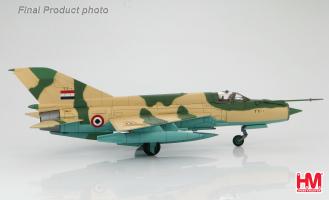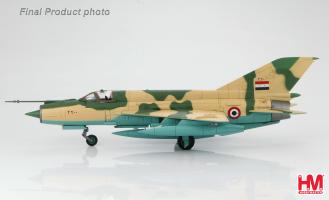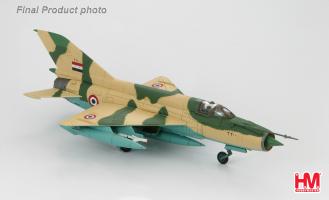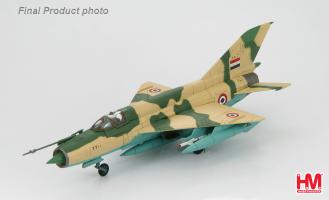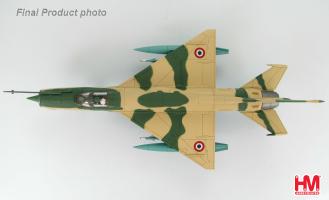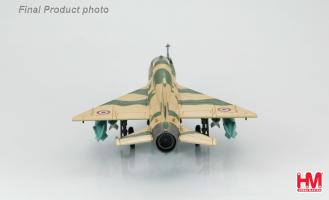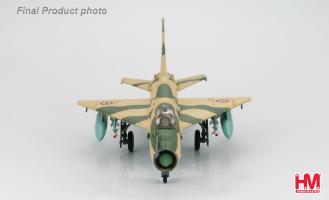Hobby Master Archive
Air Power Jets 1/72
MiG-21
Syrian Air Force MiG-21MF (2300) 5th Squadron 1973-1982 Limited Edition
Hobby Master 1/72 Air Power Series HA0143 Syrian Air Force MiG-21MF (2300) 5th Squadron 1973-1982 Limited Edition
True 1/72 scale Professionally painted Great attention to detail All markings are Tampoed (pad applied) Option to display the model on a stand that is provided Model can be shown with the landing gear in the down or up positions Loads of optional armament has been provided Canopy can be displayed open or closed Extremely heavy metal with a minimum of plastic Highly collectable
Mig-21MF Specs:
Power Plant: One 41.55kN (9,340lb st) or 64.73kN (14,550lb st) with afterburner Tumansky R-13-300 turbojet Dimensions Wingspan: 7.15m (23ft 5½in) Length: 15.76m (51ft 8½in) - including Pitot boom Max T-O weight: 9,400kg (20,725lb)
Performance Max speed: Mach 2.1 (2,230km/h - 1,385mph) above 11,000m (36,000ft) Mach 1.06 (1,300km/h - 807mph) at low level Range: 1,100km (683 miles) - internal fuel only 1,800km (1,118 miles) - with three external drop tanks, one under fuselage, one under each wing Armament One 23mm twin-barrel GSh-23 cannon with 200 rounds in belly pack Various air-to-air and air-to-ground stores carried on four under wing pylons including: K-13A “Atoll” or “Advanced Atoll” a-a missiles, UV-16-57 rocket packs, S-24 a-s rockets, 250kg and 500kg bombs 1 X centre line drop tank.
The Mig-21 was originally built by the Mikoyan and Gurevich Design Bureau in the Soviet Union with a NATO nickname Fishbed. No other jet has had as many planes produced as the Mig-21. Depending on the reference source 8,000 - 13,000 planes of all versions were made in the Soviet Union, under license to allied countries and China without license. At the time of its introduction into the Soviet Air Force service in 1959, it was exactly what they wanted. A small, fast, agile, dependable and most importantly simple making it easy to turn out great numbers of the plane. The skies of Eastern Europe, Africa, Asia and Central America seemed to be filled with thousands of the Mig-21. Because of its relatively low cost since it was heavily subsidized by the Soviets, it became the plane of choice for many third world countries. Taking this into account this plane has seen more wars then any other modern day jet. The Mig-21 was used in front line service for over 30 years equaling that of the McDonnell Douglas F-4 Phantom II. There were 5 generations of the plane in many versions and each generation brought with it great improvements over its predecessors. These are some of the countries that flew the Mig-21: Afghanistan, Albania, Algeria, Angola, Azerbaijan, Bangladesh, Burkina Faso, Bulgaria, Cambodia, China, Congo, Croatia, Cuba, Czech Republic, Egypt, Ethiopia, Finland, GDR, Guinea, Hungary, India, Indonesia, Iran, Iraq, Laos, Libya, Madagascar, Mali, Mongolia, Mozambique, Myanmar (formerly Burma), Nigeria, North Korea, Pakistan, Poland, Romania, Serbia, Slovakia, Somalia, Soviet Union, Sri Lanka, Sudan, Syria, Tanzania, Turkmenistan, Uganda, Ukraine, Vietnam, Yemen, Zambia, Zimbabwe.
القوّات الجوية العربية السورية (Al Quwwat al-Jawwiya al Arabiya as-Souriya) Syrian Air Force The Syrian Air Force was formed in 1948 when the first class of Syrian pilots completed training at a British flight school. Syria and Egypt tried to join together to form a United Arab state but when that didn’t work out Syria turned to the Soviet Union for their military needs while Egypt opted for Western technology. Syria was provided with several types of MiG aircraft of which one type was the MiG-21MF. In conflict after conflict with the Israeli Air Force Syria always came out with heavy losses. In one day alone Syria lost 100 aircraft in the skies over Lebanon with zero losses to the opposition. Through all the encounters and heavy losses MiG-21MF (2300) managed to survive two wars and was still in service well into the 1990s. The aircraft was flown with the paint scheme it arrived with from Gorky Park. The two-tone upper surface camo scheme with a sky blue under side and centerline drop tank was fine over Syria but not very effective over the Egyptian desert. The serial number is an oddity because it is smaller than usual and even smaller above the fin-flash. The MiG-21 was equipped with R-3S missiles on APU-13 launch rails on the inner wing pylons as well as R-3R missiles on APU-13 launch rails on the outer wing pylons. The aircraft had been assigned to the Syrian Air Force 5th Squadron based at or near Damascus. The Syrian roundel is very similar to that of Egypt with three concentric circles. The inner circle is black surrounded by a white circle that is surrounded by a red circle. The exception between the two roundels is the Syrian has two green stars on the opposite sides of the white circle. These are the same markings found on the Syrian national flag.
Syrian AF logo
| Added to archive | 2015-11-19 |
| Last modified | 2015-11-19 |
| Leaflet | 2009-04-01 April 2009 |
